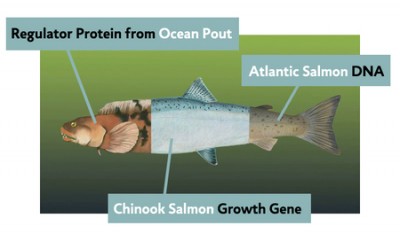GMO salmon have the potential to wreak havoc on the ecosystem and spawn mutant babies in the wild fish population. A new study about genetically modified salmon by Canadian scientists indicates the fish will dominate their environment and pass on their genetically engineered genes. The report published by the Proceedings of the Royal Society is the first known independent study on the impact GE salmon could have on the overall fish population.
Dr. Darek Moreau, who was involved with the Memorial University of Newfoundland, Canada study, stated that under hatchery conditions, “transgenic hybrids” grew more quickly than wild trout, wild salmon, and other wild hybrids. The GM hybrid fish outgrew GM salmon across the board. The genetically modified fish reportedly became more aggressive feeders than the other fish, prompting Dr. Moreau to determine that limited food resources could become a problem for other fish breeds.
An excerpt from the GM salmon study reads:
“Through experimental crosses, we demonstrate transmission of a growth hormone transgene via hybridization between a candidate for commercial aquaculture production, GM Atlantic salmon, Salmo salar, and closely related wild brown trout, Salmo trutta. Transgenic hybrids were viable and grew more rapidly than transgenic salmon and other non-transgenic crosses in hatchery-like conditions. In stream mesocosms designed to more closely emulate natural conditions, transgenic hybrids appeared to express competitive dominance and suppressed the growth of transgenic and non-transgenic (wild-type) salmon by 82 and 54 percent, respectively.”
If the genetically engineered salmon acquires all the approvals necessary from the FDA and USDA, it will be the first transgenic animal sold commercially for consumption by human. The altered salmon request is currently in the final stages of FDA approval. As previously reported by Off The Grid News, President Barack Obama has appointed a multitude of Monsanto staffers to positions of authority as both the USDA, FDA, and related agencies and commissions. Despite the dire warnings of the impact GE salmon could have on the ecosystem, the pending request has a strong likelihood of approval. The primary questions being posed to the US Food and Drug Administration involves whether or not genetically engineered Atlantic salmon designed to grow faster than their natural counterparts, can legally be raised and sold for consumption purposes in America.
It typically takes natural Atlantic salmon 36 months to reach adulthood. Genetically modified Atlantic salmon can reach the same size in as little as 16 months. When both the natural and altered version of the fish reach 18 months of age, the GE salmon typically weighs 6.6 pounds and is 24 inches long, while the natural fish weighs only 2.8 pounds and is just 13 inches long.
The process for creating genetically engineered salmon involves the use of a growth hormone from a Chinook salmon joined with a “promoter” for an ocean pout—an eel-like fish. The new growth hormone which has been spliced into the Atlantic salmon DNA directs the gene to produce hormones all year around, instead of just during the summer months.
The genetically engineered Atlantic salmon researchers created a simulated stream in a laboratory setting for monitoring the growth and interactions of the fish. The scientists raised GMO salon, wild brown trout, wild Atlantic salmon and hybrids of trout crossed with salmon all in the same manufactured stream. The Canadian scientists watched as GMO salmon and brown trout crossbreed offspring ate at an even faster rate than both their parents and the natural fish in the artificial stream. The aggressive eating habits combined with the enhanced growth rate of the GE Atlantic salmon caused alarm for the survival of other species in the event genetically altered trout found their way into open waterways.
Proponents of genetically altered salmon want the public to believe that such an escape or release would never occur, but that is exactly what Monsanto said about GMO wheat trials. After the discovery of GE wheat in Oregon nearly a decade after testing was halted, wheat prices declined significantly. Foreign buyers of American wheat cancelled contracts to for future purchases due to fears of contamination. If GE salmon found their way outside of a controlled environment, the fish market would likely take a similar financial hit.
Cross-breeding between trout and salmon occurs only rarely in the wild, to the tune of about 1 percent, according to multiple studies. Additional studies also show that when “farmed salmon” escape from dedicated hatcheries, the cross-breeding rate between the two fish breeds increases as much as 41 percent.
Researcher Krista Oke had this to say about the potential GMO salmon outcome:
“If this advantage is maintained in the wild, transgenic hybrids could detrimentally affect wild salmon populations. To the best of our knowledge, this is the first study demonstrating transmission and ecological consequences from interspecific hybridisation between a GM animal and a naturally hybridizing species. Ultimately, hybrdisisation of transgenic fishes with closely related species represents potential ecological risks of wild populations.”
 Patrick Troy, a recent OTGN guest, stated: “Our level of understanding in genetics is not even worthy of the term elementary. Our knowledge is barely past the level of swapping parts like an automobile technician replacing an incandescent bulb with an LED bulb. We have no idea of the long-term impact that GMOs will have on our health and environment, but are proceeding with their deployment purely for financial gain. Recently the presence of a viral gene contained in grown GMO foods has caused great alarm. These grown GMO foods are the product of decades of research and experimentation, and still they contained a hidden viral gene for which we have no quantifiable measurement of its dangers to our health and environment. GE salmon have been around for far less time than grown GMO foods, and the probability that they contain hidden viral genes is likely at least as high as grown GMO foods. The complexity of salmon DNA eclipses that of grown foods like wheat and soy beans. The probability of unintended consequences from GE animals in the food chain is high and, given all the factors involved, likely inevitable within a 20-year time frame.”
Patrick Troy, a recent OTGN guest, stated: “Our level of understanding in genetics is not even worthy of the term elementary. Our knowledge is barely past the level of swapping parts like an automobile technician replacing an incandescent bulb with an LED bulb. We have no idea of the long-term impact that GMOs will have on our health and environment, but are proceeding with their deployment purely for financial gain. Recently the presence of a viral gene contained in grown GMO foods has caused great alarm. These grown GMO foods are the product of decades of research and experimentation, and still they contained a hidden viral gene for which we have no quantifiable measurement of its dangers to our health and environment. GE salmon have been around for far less time than grown GMO foods, and the probability that they contain hidden viral genes is likely at least as high as grown GMO foods. The complexity of salmon DNA eclipses that of grown foods like wheat and soy beans. The probability of unintended consequences from GE animals in the food chain is high and, given all the factors involved, likely inevitable within a 20-year time frame.”
Wild salmon is by no means a threatened species. There is no logical reason to create a genetically engineered fish to feed the world. The risks of contaminating the natural fish population and negatively altering the ecosystem is just too great to allow such biotech experiments to continue
Food activists have loudly voiced the very real concern that GMO salmon will not be properly labeled, meaning Americans will have no idea they are putting an unnatural version of fish into the mouths of their children. Scientific evidence about the long-term health implications of GE salmon consumption is extremely limited. President Barack Obama has not weighed in on the growing controversy swirling around GMO crops and biotech companies such as Monsanto.
Even before the Benghazi, IRS, and journalist First Amendment rights infringement scandals took over the news cycle, not a single White House reporter felt the GMO issue was important enough to ask even one question during a press conference. During a campaign speech in Iowa, the president promised the huge crowd (and millions of television viewers) that American had a right to know what was in the food being served on their plates and sold at grocery stores.
The speech writer did a good job stringing sentences together, but Barack Obama must not have truly believed in the message that he was reading off a teleprompter. Not long after the food rights speech, President Obama began appointing Monsanto executives to positions of authority in the FDA and the USDA. With the deck stacked against organic farmers and Americans who prefer wholesome food, it is likely more and more genetically modified consumables will get a stamp of approval from federal agencies.










